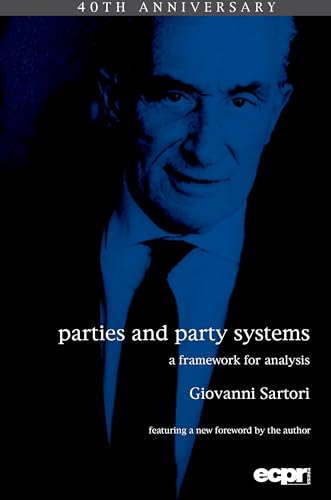Items related to Parties and Party Systems: A Framework for Analysis...

Synopsis
In this rich and broad-ranging volume, Giovanni Sartori outlines what is now recognised to be the most comprehensive and authoritative approach to the classification of party systems. He also offers an extensive review of the concept and rationale of the political party, and develops a sharp critique of various spatial models of party competition. This is political science at its best – combining the intelligent use of theory with sophisticated analytic arguments, and grounding all of this on a substantial cross-national empirical base. Parties and Party Systems is one of the classics of postwar political science, and is now established as the foremost work in its field.
"synopsis" may belong to another edition of this title.
About the Author
Giovanni Sartori was born in Florence, Italy, in 1924, and was appointed Professor of Political Science at the University of Florence in 1963. He has been a visiting Professor at Harvard and Yale, and in 1976 he succeeded Gabriel Almond as Professor of Political Science at Stanford. In 1979 he was appointed Albert Schweitzer Professor in the Humanities at Columbia University, New York, where he is now Professor Emeritus. Sartori is the author of numerous books across a range of fields in political theory and comparative politics, including Parties and Party Systems (1976), The Theory of Democracy Revisited (2 volumes, 1990), and Comparative Constitutional Engineering (2nd ed, 1997). His most recent books are Homo Videns (2nd ed, 2000), Pluralismo, Multiculturalismo, Estranei (2nd ed, 2002), and Mala Tempora (2004), which has been a bestseller in Italy. In 2005, Parties and Party Systems was also published in a Chinese translation.
"About this title" may belong to another edition of this title.
US$ 2.64 shipping within U.S.A.
Destination, rates & speedsSearch results for Parties and Party Systems: A Framework for Analysis...
Parties and Party Systems : A Framework for Analysis
Seller: GreatBookPrices, Columbia, MD, U.S.A.
Condition: New. Seller Inventory # 27413246-n
Quantity: Over 20 available
Parties and Party Systems: A Framework for Analysis (Ecpr Classics)
Seller: Best Price, Torrance, CA, U.S.A.
Condition: New. SUPER FAST SHIPPING. Seller Inventory # 9781785522611
Quantity: 1 available
Parties and Party Systems A Framework for Analysis Ecpr Classics
Print on DemandSeller: PBShop.store US, Wood Dale, IL, U.S.A.
HRD. Condition: New. New Book. Shipped from UK. THIS BOOK IS PRINTED ON DEMAND. Established seller since 2000. Seller Inventory # L1-9781785522611
Quantity: Over 20 available
Parties and Party Systems: A Framework for Analysis (Ecpr Classics)
Seller: California Books, Miami, FL, U.S.A.
Condition: New. Seller Inventory # I-9781785522611
Quantity: Over 20 available
Parties and Party Systems : A Framework for Analysis
Seller: GreatBookPrices, Columbia, MD, U.S.A.
Condition: As New. Unread book in perfect condition. Seller Inventory # 27413246
Quantity: Over 20 available
Parties and Party Systems A Framework for Analysis Ecpr Classics
Print on DemandSeller: PBShop.store UK, Fairford, GLOS, United Kingdom
HRD. Condition: New. New Book. Delivered from our UK warehouse in 4 to 14 business days. THIS BOOK IS PRINTED ON DEMAND. Established seller since 2000. Seller Inventory # L1-9781785522611
Quantity: Over 20 available
Parties and Party Systems: A Framework for Analysis (Ecpr Classics)
Seller: Ria Christie Collections, Uxbridge, United Kingdom
Condition: New. In. Seller Inventory # ria9781785522611_new
Quantity: Over 20 available
Parties and Party Systems : A Framework for Analysis
Seller: GreatBookPricesUK, Woodford Green, United Kingdom
Condition: New. Seller Inventory # 27413246-n
Quantity: Over 20 available
Parties and Party Systems : A Framework for Analysis
Seller: GreatBookPricesUK, Woodford Green, United Kingdom
Condition: As New. Unread book in perfect condition. Seller Inventory # 27413246
Quantity: Over 20 available
Parties and Party Systems
Seller: Rarewaves.com USA, London, LONDO, United Kingdom
Hardback. Condition: New. Seller Inventory # LU-9781785522611
Quantity: Over 20 available

